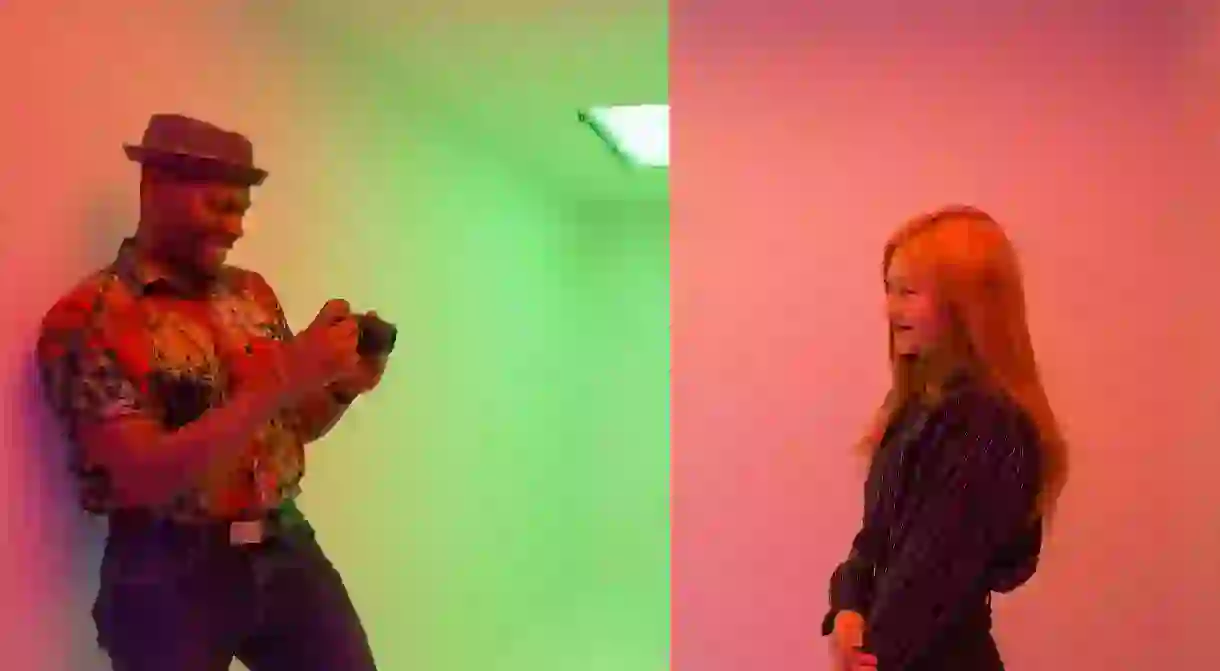SCAD's Psychedelic Installation Will Literally Change Your Perspective on Color

Venezuelan artist Carlos Cruz-Diez has been creating mind-bending, immersive installations since the 1960s. At the SCAD Museum of Art, he once again presents works that investigate color, light, and movement.

In its expansive courtyard, the SCAD Museum of Art in Savannah just installed Chromosaturation, a new work by the Venezuelan artist Carlos Cruz-Diez. Using a shipping container, Cruz-Diez has created a laboratory for investigating color and light, inside of which the viewer encounters three partitioned sections, each lit from above by a different color. In what appears to be green, blue, and red, the lights blend together on the wall and mix on the floor, creating original hues.
Walking between the different sections, the viewer’s sense of color begins to shift as he or she too, becomes flooded in light. On the outside, panels of bright, alternating colors (one with thin, curving shapes jutting out) create the illusion of movement—stare at them long enough, and they appear to start vibrating. Cruz-Diez’s work asks its audience to reconsider the relationship between color and motion and the way we view our bodies in the world: a psychedelic experience that won’t fry your brain.

Born in 1923 in Caracas, Cruz-Diez has been creating such trippy experiences since the 1960s. During a recent discussion with Storm Janse van Rensburg, SCAD head curator of exhibitions, (both the conversation and the installation are part of SCAD’s annual deFINE ART program), the artist described his long preoccupation with color: “Color is an event that changes continuously,” he said (through a translator), “we have no memory for color. Go to the store and try to match a color from memory, and you won’t be able to.”
Cruz-Diez experiments with different principles he’s conceived, such as “Couleur Additive,” the idea of juxtaposing colors to create new ones. When he speaks, he uses a language all his own to explain the way that perception works. His art is part science, part invention, and fully participatory: the viewer must interact with his pieces for them to be complete.

Before beginning the investigations that have comprised most of his practice, Cruz-Diez worked as a figurative and academic painter. A desire to break from the mainstream and create art for large groups of people in a new, groundbreaking manner led him to experiment with new materials and technologies. He’s always looking for ways to elongate his works, and the colors within them. “Every color in nature fades,” he laments. The printing materials he uses now, he was told, will last four hundred years.
His bright, graphic pieces also evidence his interest the design elements of his installations themselves. A long-time professional graphic designer, Cruz-Diez once created exhibition catalogs and posters for such luminaries as renowned artists Robert Rauschenberg and Jim Dine. Yet, while he discusses his work in both art and design, he vehemently rejects the intersection of the two fields.

“Design is about function. It’s about being clear. Art is pure invention,” he says. “If you are designing a chair, you want people to feel comfortable with the chair. If an artist would design a chair, he would make people uncomfortable.”
Indeed, Cruz-Diez’s artwork can be unnerving. Spend too long in the shipping container, and you begin to see new colors that weren’t there when you entered, your mind still racing to process the new perspectives. In another new Cruz-Diez installation within the museum, the viewer enters a white room where stripes of light shift across the walls, floor, and sculptural shapes: a sphere and a plinth sit on the floor while a cylinder hangs from the ceiling. The viewer, he says, becomes “an actor and an author at the same time” as light moves across the body.

The more people he can impact with his work, the better. It’s to give the people something: “art is generous,” he says. If the mechanisms sound complex, the work also offers a fun, immersive escape. For the moment, Cruz-Diez’s inventions transport the audience into new realms where color rules, heightening the senses. The best way to enjoy them? Succumb to the optical tricks and embrace the power of art to literally change what you see.














